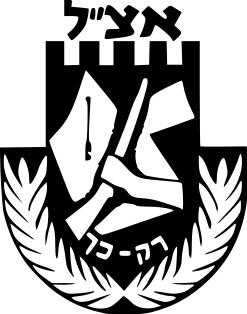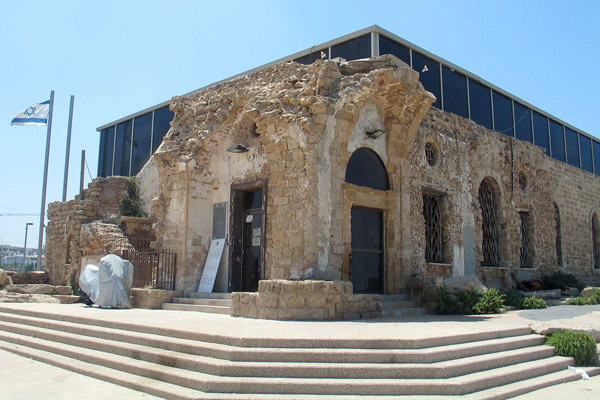I’m still not quite sure what my son learned on a class trip to the Etzel Museum. I, on the other hand, learned quite a few things — most importantly, that there’s no monopoly on the lack of compassion in Israel’s body politic.
By Akin Ajayi

For quite a while, it has become convenient to overlook the fact that once, Revisionist and mainstream Zionism shared similar objectives: Both wanted a Jewish majority in the territory controlled by the British Mandate, and neither were particularly enthused by the prospect of negotiating an equitable compromise with the Palestinian Arabs.
Because I don’t pay as much attention to my nine-year-old’s education as I should, I was rather put out when he came back from school one day bearing the emblem of Irgun Tsava’i Ha Leumi, the Etzel. Active from the 1930s until 1947, the Etzel gave muscular heft to Revisionism, Ze’ev Jabotinsky’s maximalist school of Zionism. You’d probably recognize the emblem if you saw it: a outstretched arm grasping a Sten rifle, superimposed over a map of the British Mandate territory of Palestine and Transjordan.
 I was rather perturbed. Were “they” giving kids proto-fascist leaflets at the school gates, along with football sticker books and advertisements for after-school activities?
I was rather perturbed. Were “they” giving kids proto-fascist leaflets at the school gates, along with football sticker books and advertisements for after-school activities?
No, not at all, my son explained. He’d received it during a school trip. He’d spent the day at “Beit Gidi,” the 1947-49 Etzel Museum in Tel Aviv. Oh.
I’d always though that Revisionist Zionism had long ago been discarded by historians as an aberration, a malign digression from the task of building a Jewish state. The received wisdom, as I understood it, was that the Etzel’s violent excesses ultimately placed the underground movement beyond the political pale. So how then does a visit to a museum recording – glorifying, even – the misdeeds of a discredited organization become part of the elementary school curriculum?
Perhaps I should back up a bit and try to put my thoughts in context.
The one thing – possibly the only thing – I’ve learned in over a decade living is Israel is that it is very easy for contested assertions to become immutable fact. It’s a weird form of groupthink: something to do, I suppose, with Israel’s impossibly fragmented social structure, most of us living in impregnable ideological silos defined by politics, religion, social class and mutual distrust. The received wisdom of our little worlds all-too-often become statements of indisputable truth. For us, anyway. Anyone who doesn’t agree with us is a heathen/godbotherer/pinko leftist/racist rightist.
My adopted silo is, more or less, that of the secular center-left. About Jabotinsky: our truth is that even if he and his acolytes were not quite mad, they were most certainly bad and dangerous to know. Revisionist Zionism, so the script reads, considered the political and territorial compromise of Jewish rights to the historical Land of Israel no better than collaboration. All ways and means to preserve Jewish dominion over the land were legitimate. All means, including premeditated violence.
In The Iron Wall, a seminal text on the relationship between Jews and Arabs in the Middle East, Avi Shalim frames the Revisionist doctrine thus: “[Jabotinsky] laid down two principles that formed the core of the Revisionist Zionism doctrine, and its political program. The first was the territorial integrity of Eretz Israel, the Land of Israel, over both banks of the River Jordan within the original borders of the Palestine Mandate. The second was the immediate declaration of the Jewish right to political sovereignty over the whole of this area.” (Emphasis mine.)
Which is useful to know. But it is also what social scientists call confirmatory bias; a fishing expedition on my part to find the evidence that backs up my untested assumptions. And so the question still niggled; what exactly was there to understand about the relationship between Revisionism and mainstream Zionism, outside my little silo? The only way to find out was to follow in my son’s footsteps, and to (reluctantly) do some homework of my own.
Beit Gidi was established in the early 1980s, after Tel Aviv-Jaffa Municipality gave permission for the construction of a memorial to Etzel fighters on a beachfront site in southern Tel Aviv. As museums go, Beit Gidi is a pleasant enough place, reasonably well-organized and with attentive staff. But it is rather small. I shudder to to think of the chaos that a class of fourth graders would have brought to its precincts.
No surprises that the museum’s narrative tilts towards the self-conceived bravery and patriotism of the Etzel and its fighters. This is, after all, the museum’s raison d’etre. But there is something else, more subtle but just as insistent: the repeated emphasis on of the righteousness, the correctness, of the Etzel’s political and military ideology. Menachem Begin, later to become prime minister of Israel, was a key acolyte of Jabotinsky and an Etzel commander. A wall plaque, quoting from a speech made by Begin just before the battle for control of Jaffa in 1948, captures the Etzel’s philosophy succinctly. “Show no mercy in battle, just as the enemy has no pity for our people,” it reads. “Be compassionate with women and children. Whenever someone lifts his hands in surrender, spare him. He is your prisoner. Do not harm him.” Compassion seems an odd word to use when talking about war and death. One wonders what the kids made of this.

There was also a short film, a primer setting the Etzel worldview in the broader context of Zionist activity in Palestine. In summary: the British reneged on foreign minister Lord Balfour’s 1917 promise to assist in the creation of a Jewish homeland, in the territory occupied by Mandate.[1] The British White Paper of 1922 introduced caveats to Balfour’s open-ended promise: proportional democratic representation, limits on Jewish migration, the excision of Trans-Jordan from the territory set aside for a future Jewish State.[2] The Zionist Organization, representative voice of the Jewish communities in Palestine and the Diaspora, decided to work with – rather than against – the British, whilst still keeping an eye on incrementally achieving the ultimate prize. But Jabotinsky had no time for this fudge. After a period of in-house insurgency, he split from the Zionist Organization in 1923 and founded the Revisionist Zionist Alliance. His casus belli was, to be fair, transparent. The Zionist’s official policy of compromise with the British was doomed to failure. Only resistance would suffice.
But why does all this matter? One good reason. For quite a while, it has become convenient to overlook the fact that once, Revisionist and mainstream Zionism shared similar objectives; the difference lay in how they proposed to achieve these goals. Both wanted a Jewish majority in the territory controlled by the British Mandate; neither were particularly enthused by the prospect of negotiating an equitable compromise with the Palestinian Arabs in situ when mass Jewish immigration to this corner of the Ottoman Empire began, in the 1880s.
It is, of course, important to place this understanding within the wider context of time, place and circumstances. Whatever one might think about Jewish immigration to Palestine, it – Zionism – did not emerge from a void, but rather from the urgent need to secure political and social autonomy for displaced, discriminated-against and marginalized Jewish populations. But nonetheless. There was an extant population in Palestine, towards whom Zionism – in all its hues – paid scant regard.
Let’s return to this matter of compassion. History accepts that Jabotinsky’s Revisionists were most certainly lacking in this department. The most commonly cited evidence for this POV is the massacre of Deir Yassin, in April 1948. The basic facts are well established, and there is little need to go over them again. But note this: after acknowledging the excessive casualties wrought by the Etzel, Beti Gidi’s modest exhibit on the affair attempts to contextualize it. “It is universally agreed that the Deir Yassin operation was a key point in the history of the War of Independence,” a plaque states baldly. It doesn’t have very much to say about compassion.
In any case, this interpretation reassured no-one. The blowback, both domestic and international, was immediate, and sharp. Begin, now the head of Herut, (the political party that grew from the ashes of the Etzel, and a precursor to today’s Likud) had once been something of a hero, leader of the revolt against perfidious Albion. All that status was lost. When he visited the United States in late 1948, a cluster of Jewish intellectual heavyweights wrote an open letter to the New York Times to protest. Herut, they said was “closely akin in its organization, methods, political philosophy and social appeal to the Nazi and Fascist parties.” Whatever popularity Revisionism had enjoyed had evaporated by the time of the first Israeli legislative elections, in early 1949. Herut’s Revisionists secured a meagre 11 percent of the national vote. Mapai, the left-wing Workers’ Party, headed by Ben-Gurion, became the party of government and the accepted voice of mainstream Zionism: thus the political landscape remained, more or less, for a generation plus some more.
The Revisionists had it coming, one might surmise. But perhaps not. We can agree that the Revisionists didn’t have moral correctness on their side. They did not behave with compassion, despite their protestations to the contrary. But then, did mainstream Zionism either? The divide between the two, after all, rests on this distinction.
Coincidentally, I happened to be reading Tom Segev’s book 1949: The First Israelis, the week my son went to Beit Gidi. There’s an interesting passage about a third of the way through, describing efforts made by the Mapai-led government to absorb new immigrants in the new State of Israel. An abandoned Arab village, on the outskirts of Jerusalem, was earmarked for migrants from Poland, Slovakia, and Romania. It was given a new name – Givat Shaul Bet – and plans came together very quickly to resettle the new migrants. “By the summer of 1949, five acres of olive groves had already been ploughed, and 300 crates of plums had been marketed from the village orchards,” Segev writes.
But not all was bucolic tranquility. Segev reports that four noted scholars, one of them the philosopher Martin Buber, sent a sharp letter to Ben Gurion’s government. They asked that this particular village be left uninhabited, or at least its settlement postponed. “(T)he time has not yet come to decide on establishing a Jewish settlement in that village…(which) has become infamous throughout the Jewish world, the Arab world and the whole world.” The original name of the Arab village? Deir Yassin.
Their letter went unanswered. No surprises there.
To be honest, I’m not sure what precisely my son did learn from his trip to Beit Gidi. (We had a short chat about the trip afterwards. Judging from his descriptions, he seems to believe that Jabotinsky was a cross between the Scarlet Pimpernel and James Bond[3].) I learnt quite a few things, though. Most important of all, that there’s no monopoly on the lack of compassion in the Israeli body politic. I’ll try to remember this the next time I read that today’s Likud is the political successor to Herut and to Jabotinsky. After all, today’s Zionist Camp, the former Labor Party, is the political successor to Mapai, the institutional party of the Israeli left. And in the matter of Deir Yassin, and many others besides, left and right should probably share the blame equally.
Akin Ajayi is a freelance writer and editor, based in Tel Aviv.
[1] It is worth noting, even if just in passing, that the history of British colonialism is nothing if not a history of broken promises.
[2] The last on account of the British having carelessly promised this territory to someone else. See footnote (1) above.
[3] But he also knew that Jabotinsky was the first translator of the “Sherlock Holmes” books into Hebrew. Which must count for something, no?
